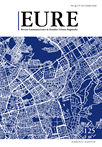Spaces of poverty in the urban periphery and interior suburbs of Mexico City. The accumulated disadvantages
DOI:
https://doi.org/10.4067/S0250-71612016000100001Keywords:
poor neighbourhoods, accumulated disadvantages, urban peripheryAbstract
The socio-spatial differentiation in the urban space refers to the geographic concentration of poverty. In the literature there is an absence of studies about poverty spaces in cities, relating the socio-economic situation of the underprivileged to particular urban spaces. Poor neighbourhoods tend to group together in clusters dominated by situations of social exclusion. This study presents an analysis of the main features and disadvantages of families living in poor spaces in Mexico City through the results of 329 surveys applied in poor neighbourhoods of the urban periphery and the inner suburb. Special attention is given to the measure of poverty levels, identifying four categories: non-poverty, moderate poverty, extreme poverty and indigence. This measuring is based on access to basic needs, labour condition, and social cohesion according to peripheral and suburban location.Downloads
Published
How to Cite
Issue
Section
License
Copyright (c) 2015 Revista EURE - Revista de Estudios Urbano Regionales

This work is licensed under a Creative Commons Attribution 4.0 International License.
Al momento de aceptar la publicación de sus artículos, los autores deberán formalizar la cesión de derechos de autor a EURE, según las condiciones establecidas por la Revista.
Ésta establece que el autor autoriza a EURE de manera gratuita, exclusiva e ilimitada a reproducir, editar, publicar, distribuir, publicitar, comercializar y traducir el artículo, a cualquier soporte conocido o por conocer y desarrollar.
Del mismo modo, los autores aseguran que el artículo propuesto es original, no publicado y no propuesto para tal fin a otro medio de difusión.


